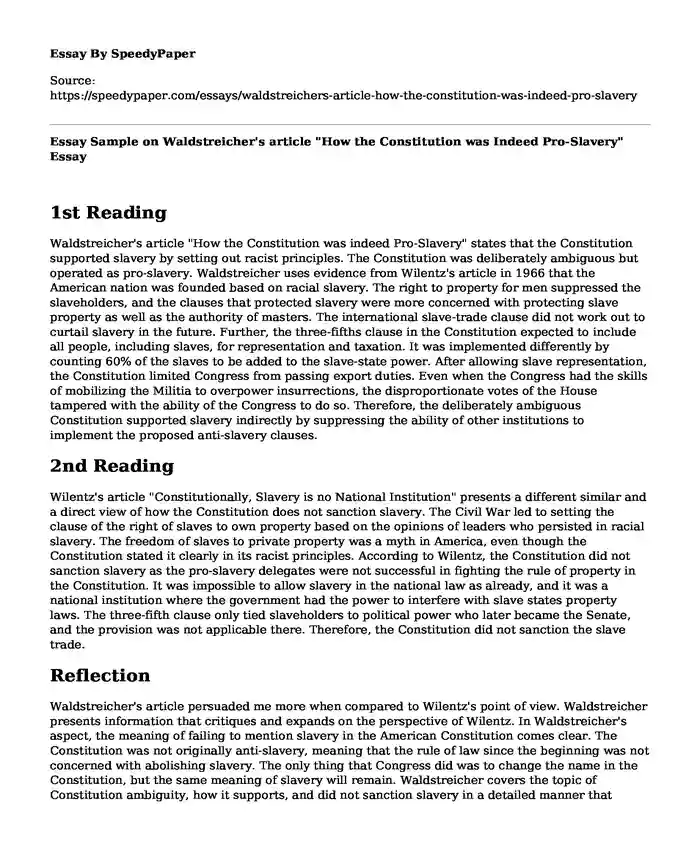
| Type of paper: | Report |
| Categories: | Reflection Slavery Constitution Comparative literature |
| Pages: | 3 |
| Wordcount: | 600 words |
1st Reading
Waldstreicher's article "How the Constitution was indeed Pro-Slavery" states that the Constitution supported slavery by setting out racist principles. The Constitution was deliberately ambiguous but operated as pro-slavery. Waldstreicher uses evidence from Wilentz's article in 1966 that the American nation was founded based on racial slavery. The right to property for men suppressed the slaveholders, and the clauses that protected slavery were more concerned with protecting slave property as well as the authority of masters. The international slave-trade clause did not work out to curtail slavery in the future. Further, the three-fifths clause in the Constitution expected to include all people, including slaves, for representation and taxation. It was implemented differently by counting 60% of the slaves to be added to the slave-state power. After allowing slave representation, the Constitution limited Congress from passing export duties. Even when the Congress had the skills of mobilizing the Militia to overpower insurrections, the disproportionate votes of the House tampered with the ability of the Congress to do so. Therefore, the deliberately ambiguous Constitution supported slavery indirectly by suppressing the ability of other institutions to implement the proposed anti-slavery clauses.
2nd Reading
Wilentz's article "Constitutionally, Slavery is no National Institution" presents a different similar and a direct view of how the Constitution does not sanction slavery. The Civil War led to setting the clause of the right of slaves to own property based on the opinions of leaders who persisted in racial slavery. The freedom of slaves to private property was a myth in America, even though the Constitution stated it clearly in its racist principles. According to Wilentz, the Constitution did not sanction slavery as the pro-slavery delegates were not successful in fighting the rule of property in the Constitution. It was impossible to allow slavery in the national law as already, and it was a national institution where the government had the power to interfere with slave states property laws. The three-fifth clause only tied slaveholders to political power who later became the Senate, and the provision was not applicable there. Therefore, the Constitution did not sanction the slave trade.
Reflection
Waldstreicher's article persuaded me more when compared to Wilentz's point of view. Waldstreicher presents information that critiques and expands on the perspective of Wilentz. In Waldstreicher's aspect, the meaning of failing to mention slavery in the American Constitution comes clear. The Constitution was not originally anti-slavery, meaning that the rule of law since the beginning was not concerned with abolishing slavery. The only thing that Congress did was to change the name in the Constitution, but the same meaning of slavery will remain. Waldstreicher covers the topic of Constitution ambiguity, how it supports, and did not sanction slavery in a detailed manner that Wilentz. It is the view of Waldstreicher that a reader understands the hypocrisy of American leaders after the Civil War in promoting human freedom by curtailing slavery. Wilentz only covers the racist principles set out in the Constitution and how they failed to succeed in promoting the welfare of slaves in America. It is through Waldstreicher's view that the reader realizes that the Constitution was not initially anti-slavery. Slaves remained property instead of gaining their Constitutional right of representation and own property like other men. One can say that Waldstreicher brings out the irony of America's nation in fighting slavery through the nation's dedication to human equality and liberty for everyone.
Works Cited
Waldstreicher, David. "How the Constitution Was Indeed Pro-Slavery," The Atlantic, 2015. https://www.theatlantic.com/politics/archive/2015/09/how-the-constitution-was-indeed-pro-slavery/406288/#about-the-authors
Wilentz, Sean. "Constitutionally, Slavery Is No National Institution." The New York Times, 2015. https://www.nytimes.com/2015/09/16/opinion/constitutionally-slavery-is-no-national-institution.html?mcubz=1
Cite this page
Essay Sample on Waldstreicher's article "How the Constitution was Indeed Pro-Slavery". (2023, Mar 03). Retrieved from https://speedypaper.net/essays/waldstreichers-article-how-the-constitution-was-indeed-pro-slavery
Request Removal
If you are the original author of this essay and no longer wish to have it published on the SpeedyPaper website, please click below to request its removal:
- Gothic Architecture Characteristics
- Essay Sample: Get Me Roger Stone
- Free essay: Food Poisoning Claims and Event Risk Solving
- Selfish Gene Theory and Franz De Waal's Idea
- Analysis Paper Example on Marketing Mix and Four P's of Coca-Cola Company
- Free Essay Example. the Homeless and Health Promotion
- Free Essay: Information Security Continuous Monitoring-Challenges and Solutions
Popular categories




